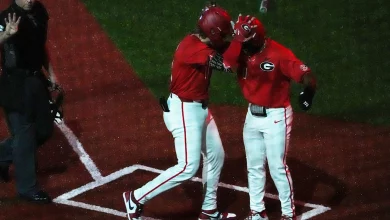Deion Sanders proposes a major change to college football spring games, suggesting more competitive formats and enhanced fan engagement.

Deion Sanders, one of the most charismatic and innovative figures in the world of sports, has consistently pushed boundaries both on and off the field throughout his career. From his playing days as a Hall of Fame cornerback to his current role as the head coach of the Colorado Buffaloes, Sanders has always sought to challenge conventional thinking, especially when it comes to improving the game of football. One area where Sanders has set his sights on change is college football’s spring games, a traditional fixture in college football that has long been considered a laid-back, somewhat low-stakes exhibition event for teams to showcase their talent in front of fans before the regular season begins.
However, Sanders has proposed a major overhaul of the current spring game format, suggesting that college football programs shift from these non-competitive exhibitions to more intense, competitive games that not only benefit the players but also enhance fan engagement and raise the stakes for all involved. Sanders’ vision is to make spring games a more meaningful experience for players, coaches, and fans alike—creating a spectacle that blends the excitement of game-day football with the developmental goals of the spring period.
In this article, we will explore Sanders’ proposed changes to college football spring games, why he believes these changes are necessary, and what impact they could have on the future of college football. We will also dive into the historical context of spring games, the challenges that could arise from implementing Sanders’ ideas, and how this could potentially reshape the way teams approach their spring practices and fan engagement.
The Traditional College Football Spring Game
Spring games have been a staple of college football for decades. Traditionally, spring games serve as an opportunity for coaches to evaluate their players, particularly newcomers, backups, and freshmen, while also giving fans a chance to see their team in action for the first time since the previous season’s bowl game. These games are usually non-contact or lightly-contact scrimmages, designed to prevent injuries while still allowing players to get in some competitive reps.
While spring games provide some level of excitement for fans, they are often seen as a mere formality. The outcomes of these games rarely matter in the larger context of the season. In many cases, coaches use the spring game primarily as a tool for experimentation, trying out different player combinations and evaluating various position groups without putting too much focus on the final score. As a result, the atmosphere of spring games can sometimes feel lackluster, as fans know that these contests are not representative of the intensity and competition that comes with a real game.
Although these events typically feature a good turnout from fans who are eager for football action, they often lack the true excitement that comes with a high-stakes, competitive environment. The scores don’t count, the players aren’t playing at full intensity, and the energy surrounding these games is often more about showcasing the athletes rather than seeing them compete at the highest level.
This is where Deion Sanders’ vision comes into play.
Deion Sanders’ Proposal: A More Competitive Spring Game Format
Deion Sanders is no stranger to shaking things up in the world of football. His coaching style at Jackson State University made waves, with his emphasis on bringing a higher level of energy, discipline, and excitement to the game. Now that he’s leading the Colorado Buffaloes, Sanders is looking to bring that same level of innovation to college football’s spring games.
Sanders’ proposal centers around making spring games much more competitive by moving away from the traditional, exhibition-style matchups. Instead of having players participate in a scrimmage with little to no contact, Sanders believes these games should be structured to mirror regular-season contests, complete with a real competitive edge and higher stakes for everyone involved.
There are several key aspects of Sanders’ proposal that stand out:
1. Making the Spring Game a Real Game
One of the central elements of Sanders’ idea is transforming the spring game into a real game, with the same level of intensity and competition that fans see during the regular season. This means more contact, more aggressive play calling, and less of the “soft” football that often characterizes spring games. Sanders has expressed his belief that spring games should not be treated like practice sessions or glorified scrimmages, but rather as an opportunity to showcase the team’s true potential, under game-like conditions.
Sanders’ vision is to raise the stakes for players and coaches by giving them an actual, competitive environment where both sides are fully engaged in trying to win. In his view, the best way to get the most out of spring practice is by creating situations that simulate real-game pressure, allowing players to hone their skills while also learning how to perform under the spotlight.
2. Increased Fan Engagement and Excitement
Deion Sanders is all about engaging the fans. His high-energy persona, both as a player and as a coach, has always been about bringing excitement and entertainment to the game. Under Sanders’ proposal, spring games would be designed to create a more thrilling atmosphere for fans. The competitive nature of these games, combined with innovative fan-friendly elements, would turn the spring game into an event that draws fans in like a regular-season game.
Sanders has suggested introducing features like fan interaction, tailgating, and gameday experiences that make the spring game feel like more than just a practice session. This could include live performances, fan zones, and even incorporating social media interactions during the game to keep fans engaged and invested in the action. By making the spring game a true spectacle, Sanders believes it will increase fan excitement and draw larger crowds, making it a marquee event rather than a side note in the football calendar.
3. Player Development and Evaluation
While Sanders’ proposal emphasizes the competitive nature of the spring game, it doesn’t mean the game would lose its primary purpose of player development. In fact, Sanders believes that the intensity of a real competition will better simulate the pressure of a regular-season game and give coaches the opportunity to evaluate their players more effectively.
By having players go full-speed in a real game scenario, coaches can see how they respond to pressure, how they perform in high-stakes situations, and how they handle the intensity of a real football environment. This would provide valuable insight into the team’s strengths and weaknesses, helping coaches make more informed decisions when building their depth chart heading into the season.
Additionally, Sanders believes that by fostering more competition in the spring game, players are more likely to give their best effort and show their true abilities. In a non-competitive scrimmage, players may not be as motivated to perform at their highest level. But in a more competitive environment, players will be more inclined to leave everything on the field, leading to better evaluation for coaches and a higher level of preparation for the team.
4. Raising the Stakes and Building Momentum for the Regular Season
Spring games typically come at the tail end of a grueling spring practice schedule, and while they’re important for player development, they often don’t provide much of a “test” for teams. By making spring games more competitive, Sanders believes it will give teams a chance to build momentum heading into the regular season. A hard-fought, intense spring game could serve as a springboard for the team’s success in the months leading up to the season opener, boosting morale and creating a sense of excitement.
The added competition will push players to elevate their performances, creating a more dynamic and engaging atmosphere that excites both the players and the fans. If teams treat the spring game as a true contest with consequences, it could be the perfect catalyst for building team chemistry and preparing for the challenges ahead.
Challenges and Potential Drawbacks
While Sanders’ proposal for more competitive spring games is exciting, there are several challenges that could arise from making this transition. One concern is player safety. By increasing the level of contact and competition in the spring game, there is a risk of injuries, especially given that many players have not been fully conditioned for the physical toll of a real football game after months of off-season training.
Additionally, coaches may be hesitant to push players too hard in a spring game, knowing that it is only a preseason event and that the main goal is player development rather than winning. There’s also the question of balancing the need for competitive play with the necessity of evaluating all players on the roster, including those who may not be starting players but are still vital to the overall depth of the team.
Another potential drawback is the shift in fan expectations. If spring games become more competitive and high-stakes, fans might begin to expect that level of intensity year-round. This could put pressure on programs to maintain that level of excitement and competitiveness during the regular season, which could be unsustainable, especially if teams experience injuries or struggles throughout the year.









